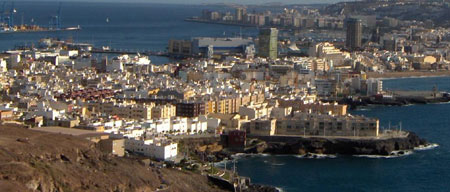Home > Study in Spain > City Guide > Las Palmas
Las Palmas City Guide
- Places of Interest
- Maps
- Getting to
- Getting around the city
The capital of the autonomous región of the Islas Canarias, just off the coast of north-west Africa, and the largest city in the European Union outside of Europe, Las Palmas combines the joys of an exotic beach resort with all the excitement of a global city. If that isn't enough to persuade you, how about the fact that Las Palmas has been described as having "the best climate in the world", due to its summer temperatures which last all year round, meaning you don't have to miss a single day on the beach? Combine this with an interesting cultural heritage, and you have the city that has everything!
El Real de Las Palmas was founded in 1478, and soon became a military bastion. The city gained fame in 1492 when Christopher Colombus anchored in the city's port on his first trip to the Americas, and stopped there again on his way back to Spain. There is now a museum in the city commemorating these events. Today, the city is a cosmopolitan hub of activity, with five different beaches and a busy seaport.
If you are looking for somewhere with a beautiful climate, great beaches, a big city atmosphere and a wealth of cultural activities, then Las Palmas is the place for you. Come and enjoy this fantastic city in one of eduSpain's most exotic locations, and come back with a better knowledge of Spanish, a great tan and some fantastic memories.
Places of Interest
Bandama Caldera
Situated about 10km out of the city is a volcanic caldera, which has been recognized as a point of geological interest. You can walk to the bottom of the caldera, which takes about half an hour, where you will be able to see an array of different coloured volcanic ash and some interesting plants originating from the Canary Islands. Open all week from 9am-6pm.
La Plaza de Santa Ana
This is at the heart of Las Palmas old town, and is where much of the history of the city is rooted. This is where you will find the cathedral, the Episcopal Palace, and the Casas Consistoriales, with their beautiful neoclassical façades.
Castillo de La Luz
This is the first defensive building that was built in Gran Canaria after the conquest of the island. It dates back to 1494. Situated in the trendy Puerto district, today it is used as a cultural centre for art exhibitions.
Playa de las Canteras
This beach, a favourite among palmenses, is also to be found in the Puerto district. It is described as the "pearl of Las Palmas" and a great place to while away a day in the sun.
El Parque Santa Catalina
Close to the Playa de las Canteras is El Parque de Santa Catalina, which is much more than just a park. Here is where the majority of the shows that take place in the city are performed, and the place to come for concerts and carnival events. In this park you can also find a Science Museum and the Edifico Miller, which is described as a "multidisciplinary cultural activity centre".
El Auditorio Alfredo Kraus
Designed by the architect Óscar Tusquets, this grand building is one of Las Palmas trademark sights. It is situated to the north-east of the Playa de las Canteras, facing out onto the Atlantic Ocean, and is used for meetings and music events.
La Isleta
This is a protected mountainous peninsula area that has been made into a suburb called La Isleta. Highlights include the El Confital beach and the suburb of Las Coloradas, from which you can see beautiful panoramas of the city.
Museums
Museo Canario
This museum, open all year round, gives you a great insight into the Canary Islands' past, with a wide range of archeological artefacts from the pre-Hispanic years.
La Casa de Colón
This museum is situated in the house where Colombus is said to have slept while passing through Gran Canaria on his way to the Americas. The museum is made up of 13 rooms, detailing the Canary Islands' relationship with the Americas.
El CAAM
This modern art museum is situated behind the cathedral, and contains pieces from Spanish, African, European and American artists.
Maps
Getting to Las Palmas
By Air
10 million people pass through Las Palmas airport every year, and more than 200 airlines fly to and from the city. The number 60 bus connects the airport with the city centre and runs every half an hour.
By Boat
There are also ferries which come into Las Palmas Puerto de La Luz. The port is connected with 380 ports around the world and 30 maritime lines. From here it is easy to reach the city centre on foot.
Getting around the city
The city boasts 42 bus lines, which can take you to all parts of the city, and also a tourist bus, which is useful for getting around the main sights and beaches. There are many taxis in the city which can be picked up on the street or from a taxi rank.
Tips
It is important to be aware of the city's administrative hours. These are:
- Mornings: Monday – Friday, from 8.30am – 2.30pm. (1.30pm in summertime: 1 July – 30 September
- Afternoons: Thursdays, from 4.30 – 7.30pm
- Saturdays: From 10am – 1pm.
- Shops are open from 9am – 1pm and then from 4.30 – 8pm.
- Banks are open from 8.30am – 2.30pm.
Don't miss the city's carnival celebrations, which are famous worldwide.

